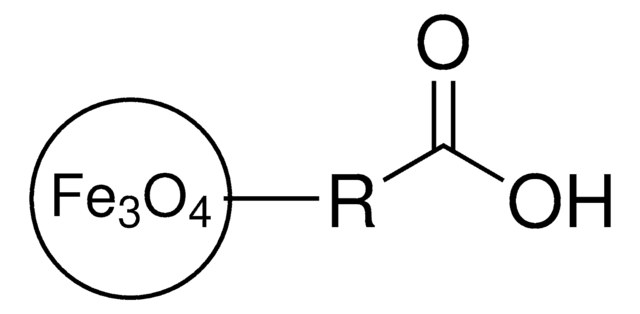725358
Iron oxide(II,III), magnetic nanoparticles solution
10 nm avg. part. size, 5 mg/mL in H2O
Sinónimos:
Magnetic iron oxide nanocrystals, Magnetite, Superparamagnetic iron oxide nanoparticles
Seleccione un Tamaño
Seleccione un Tamaño
About This Item
Productos recomendados
Formulario
dispersion
nanoparticles
concentración
5 mg/mL in H2O
magnetización
>45 emu/g, at 4500Oe
tam. prom. pieza
10 nm
tamaño de partícula
9-11 nm (TEM)
densidad
1.00 g/mL at 25 °C
cadena SMILES
O=[Fe].O=[Fe]O[Fe]=O
InChI
1S/3Fe.4O
Clave InChI
SZVJSHCCFOBDDC-UHFFFAOYSA-N
¿Está buscando productos similares? Visita Guía de comparación de productos
Categorías relacionadas
Descripción general
Aplicación
- Optical resolution of ephedrine: A study explored the optical resolution of racemic ephedrine using various derivatives of tartaric acid, presenting a method that could refine the production of pharmaceutical-grade ephedrine hydrochloride (Bánhegyi et al., 2022).
- Stereoselective forensic analysis: Supercritical fluid chromatography coupled with tandem mass spectrometry was used to perform a stereoselective analysis of ephedrine and its isomers in seized methamphetamine samples, offering insights into forensic applications of ephedrine hydrochloride (Segawa et al., 2021).
- Chiral analysis of stimulants: A chiral high-performance liquid chromatography-tandem mass spectrometry method was applied to determine amphetamine-type stimulants, including ephedrine, in forensic samples, providing a tool for the precise separation and identification of chiral drugs (Schwelm et al., 2020).
Código de clase de almacenamiento
12 - Non Combustible Liquids
Clase de riesgo para el agua (WGK)
nwg
Punto de inflamabilidad (°F)
Not applicable
Punto de inflamabilidad (°C)
Not applicable
Elija entre una de las versiones más recientes:
¿Ya tiene este producto?
Encuentre la documentación para los productos que ha comprado recientemente en la Biblioteca de documentos.
Los clientes también vieron
Artículos
Explore DNA-functionalized nanoparticles in sensors for precise target analyte detection. Learn about types, synthesis, functionalization, and design optimization, with insights into challenges and prospects.
Professor Mitsuhiro Ebara provides insights on several types of smart nanofiber mesh systems that have been explored for different drug delivery purposes.
Professor Hui Mao explores the use of superparamagnetic iron oxide nanoparticles (INOPs) that offer an alternate contrast-enhancing mechanism.
Prof. Yadong Yin discusses various synthesis methods of magnetite nanocrystals and their applications in different fields.
Active Filters
Nuestro equipo de científicos tiene experiencia en todas las áreas de investigación: Ciencias de la vida, Ciencia de los materiales, Síntesis química, Cromatografía, Analítica y muchas otras.
Póngase en contacto con el Servicio técnico

